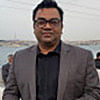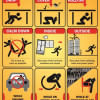Shaking of the ground

We were travelling back to Istanbul with a Turkish tourist group when the news of a 7.8-magnitude quake reached us. We asked our fellow passengers whether members of their families were safe back home. Most of them hailed far from the Syrian border towns in the southeastern provinces and seemed unperturbed by the news.
My wife, who attended a training in Turkey in 1999, recalled the catastrophic earthquake of 7.6 magnitude which claimed over 18,000 lives. Our tour guide sounded defiant. "Well, we are more sophisticated technologically now. Let's hope it doesn't come to that." "We have been paying earthquake tax ever since that incident. We better be prepared for such calamities," another one added with a hint of irony.
From our cruise ship, access to the outside news was rather voluntary. Unless you have paid for your roaming data or WiFi hotspots, there was little reason for one to be aware of what was going on back home. The extent of the disaster was yet to be known. Behind the facade of our indifference, little did we know that our ship, too, was vulnerable to a potential tsunami as an aftershock to the quake. The instant reactions of our Turkish friends intrigued me, but it was something to which we could all relate.
As Bangladeshis from a hotspot of disasters, both heaven- and human-made, after every tragic incident in the country – be it a launch capsize, a factory fire, a flood in the plain, or a storm in the forest – we get calls from friends from abroad asking about our safety. In most cases, we nudge our shoulders to suggest that our country is not that small where we need to be affected by every "unnatural" event. We allow our pride to speak for us. Nobody likes to be reduced to objects of pity and misery, although nature regularly reminds us of our smallness in the grand scheme of things.
The fault, however, in this instance, lies in the shifting tectonic plates on which we have garnished our lives full of consumption. On the early morning of February 6, when residents of Turkey's Gaziantep province were sleeping, many of the buildings that stood tall to poke the skyscape "pancaked" or fell like a deck of cards. The Turkish authorities estimated that over 5,600 buildings have collapsed in the southeastern provinces. The death toll in Turkey and Syria has already climbed above 21,000 as rescue crews look for survivors trapped under toppled buildings. Freezing winter weather has impeded the rescue efforts, and the actual figure of losses is likely to grow eight-fold, according to WHO.

The series of earthquakes is a grim reminder that we should never let our guard down against nature. Scientists keep telling us about the seismic gaps; there is usually a pause between ruptures – especially in the fault zones. If you live in an active seismic zone, disasters can strike anytime. The tectonic plates under the earth's surface keep adjusting, causing us to feel minor tremors now and then. During major shifts of the plates, the punch gets mightier. The Anatolian Faultline was one such ticking time-bomb. The visual manifestation of the disaster could be seen through the demolition of buildings and roads as if a giant earth was wiping off dust and fleas from its crust. The debris both give rise to and hide human stories. The challenge now is to stay alive in a hostile environment, help others to find shelter, heal the wounded, and bury the dead before we prepare for the next jolt.
As they say, earthquakes do not kill people, but bad buildings do. With the full unpacking of horrors, questions are now being asked in Turkey: What happened to all the better building practices that were supposed to take place following the 1999 earthquake? What happened to the quake-resistant designs? Why were some of the emergency assembly points converted to apartment complexes? How about the retro-fittings needed for older buildings, primarily for public places like schools and hospitals? Have there been efforts to remove the relatively weaker portions of the buildings?
These questions are equally valid for Bangladesh. Located at the borders of several active tectonic plates, we face the risk of a similar or greater earthquake. Our placement in the world's largest river delta close to sea level also makes us prone to major tsunamis which could be triggered as an aftermath of an earthquake. The human tragedy in Turkey serves as a warning for all of us. Nature, indeed, is a great leveller. Images of the disaster remind us of our interlinked fate. The wailing of surviving relatives, the helplessness of rescue operators, and the plights of the dead touch us on so many levels.
The images get transferred from one media to another. Media gurus know which images work better to get the attention of humanitarian appeals. A wailing dog holding on to the hand of its trapped master or a trapped young girl trying to comfort her brother shelved between concrete slabs shake the core of our human selves. Then again, would I be okay with projecting my last moments before the world and compromising my dignity? Communicating disasters is a tricky topic that swings between public awareness and individual privacy rights. The images are necessary to urge the public to action. At the same time, it is important that we remember the faces behind the stories are not mere objects to be exploited. Often, when these images enter the interpretive frameworks, we realise that certain images are foregrounded at the expense of others. The coverage of an incident has a proven effect on how a story is remembered. Some stories thrive, while others fade. Some stories continue to develop in the imagination of others, garnering power and prompting positive energies for change. The reverse can also be true.
Pundits keep on referring to Bangladesh as an active seismic site. The onus is on us to learn from these stories to better prepare ourselves.
The gesture to stand by our brothers and sisters in need by both the government and the public is laudable. We should also be concerned about handpicking disasters. Say, for instance, the victims of the trouble-torn Syria should not receive lesser attention – like the media has given it. The frequency and curation of images construct our memories and responses. We should be alive to the way stories of disasters are told and retold. Above all, we should be aware that our plight as a human race is interconnected. We keep human stories alive by being humane.
Dr Shamsad Mortuza is a professor of English at Dhaka University.

 For all latest news, follow The Daily Star's Google News channel.
For all latest news, follow The Daily Star's Google News channel. 










Comments